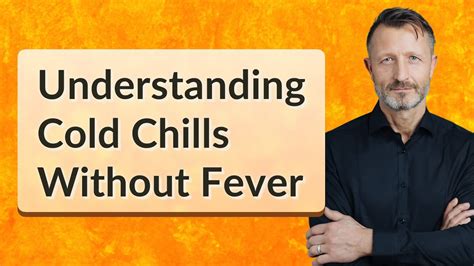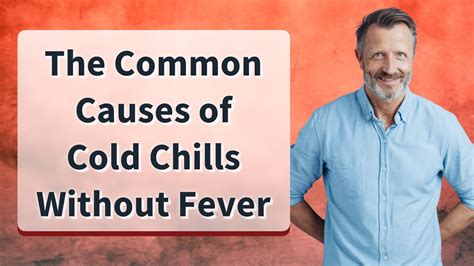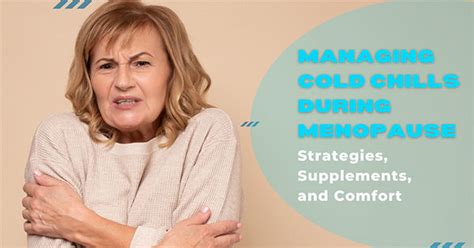Intro
Experience cold chills without fever? Learn causes, symptoms, and remedies for chilled sensations, including hypothyroidism, anemia, and anxiety, to find relief from unexplained coldness.
Getting cold chills without a fever can be a puzzling and uncomfortable experience. It's natural to associate chills with a fever, as the two often go hand-in-hand when we're fighting off an infection. However, there are many instances where chills can occur without an accompanying fever. In this article, we'll delve into the possible causes of cold chills without fever, exploring the various factors that can contribute to this phenomenon. Whether you're experiencing recurring chills or a one-time episode, understanding the underlying reasons can help you better manage your symptoms and seek appropriate medical attention when needed.
The sensation of cold chills can be quite unsettling, leaving you feeling uneasy and searching for answers. As we explore the topic further, it's essential to recognize that chills without fever can be a symptom of various conditions, ranging from mild to severe. By examining the potential causes and factors that contribute to cold chills, we can work towards finding relief and improving overall well-being. So, let's dive into the world of cold chills without fever, and discover the insights that can help you navigate this complex issue.
The human body is a intricate and fascinating system, with many interconnected processes that work together to maintain homeostasis. When we experience cold chills without fever, it's often a sign that our body is responding to a specific stimulus or stressor. This could be related to our environment, lifestyle, or underlying health conditions. As we explore the possible causes of cold chills without fever, we'll consider factors such as anxiety, stress, and hormonal changes, as well as more serious conditions like anemia, hypothyroidism, and certain neurological disorders. By gaining a deeper understanding of these factors, we can develop effective strategies for managing cold chills and promoting overall health.
Understanding Cold Chills

Physiological Response to Cold
When we're exposed to cold temperatures, our body responds by trying to conserve heat. This can lead to a range of physiological changes, including vasoconstriction (narrowing of blood vessels), increased heart rate, and shivering. These responses help to reduce heat loss and maintain our core body temperature. However, in some cases, our body may overreact to the cold stimulus, leading to an exaggerated response that can manifest as cold chills.Causes of Cold Chills Without Fever

Anxiety and Stress
Anxiety and stress can have a profound impact on our physical health, including our temperature regulation. When we're experiencing high levels of stress or anxiety, our body's "fight or flight" response is triggered, leading to a range of physiological changes. This can include an increased heart rate, rapid breathing, and vasoconstriction, which can cause our body to feel cold. In some cases, this response can be intense enough to cause cold chills, even if we're not experiencing a fever.Managing Cold Chills Without Fever

Lifestyle Changes
Making lifestyle changes can have a significant impact on our overall health and well-being. By incorporating stress-reducing techniques, regular exercise, and a balanced diet into our daily routine, we can help manage cold chills and prevent them from occurring in the first place. Additionally, getting enough sleep and avoiding exposure to cold temperatures can help regulate our body's temperature and prevent cold chills.Seeking Medical Attention

When to Seek Help
It's essential to seek medical attention if you're experiencing any of the following: * Recurring or severe cold chills * Fever above 102°F (39°C) * Difficulty breathing or shortness of breath * Chest pain or discomfort * Severe headache or confusionWhat are the most common causes of cold chills without fever?
+The most common causes of cold chills without fever include anxiety and stress, hormonal changes, anemia, hypothyroidism, and certain neurological disorders.
How can I manage cold chills without fever?
+Managing cold chills without fever requires a comprehensive approach that addresses the underlying causes. This can include practicing stress-reducing techniques, engaging in regular exercise, eating a balanced diet, getting enough sleep, and avoiding exposure to cold temperatures.
When should I seek medical attention for cold chills without fever?
+You should seek medical attention if you're experiencing recurring or severe cold chills, fever above 102°F (39°C), difficulty breathing or shortness of breath, chest pain or discomfort, or severe headache or confusion.
As we conclude our exploration of cold chills without fever, we hope that you've gained a deeper understanding of this complex issue. By recognizing the possible causes and taking steps to manage our symptoms, we can work towards finding relief and improving our overall health. If you're experiencing recurring or severe cold chills, don't hesitate to seek medical attention to rule out any underlying conditions. Remember to prioritize your health and well-being, and don't hesitate to reach out to a healthcare professional if you have any concerns. Share your thoughts and experiences in the comments below, and let's work together to build a community that supports and empowers each other to take control of our health.
